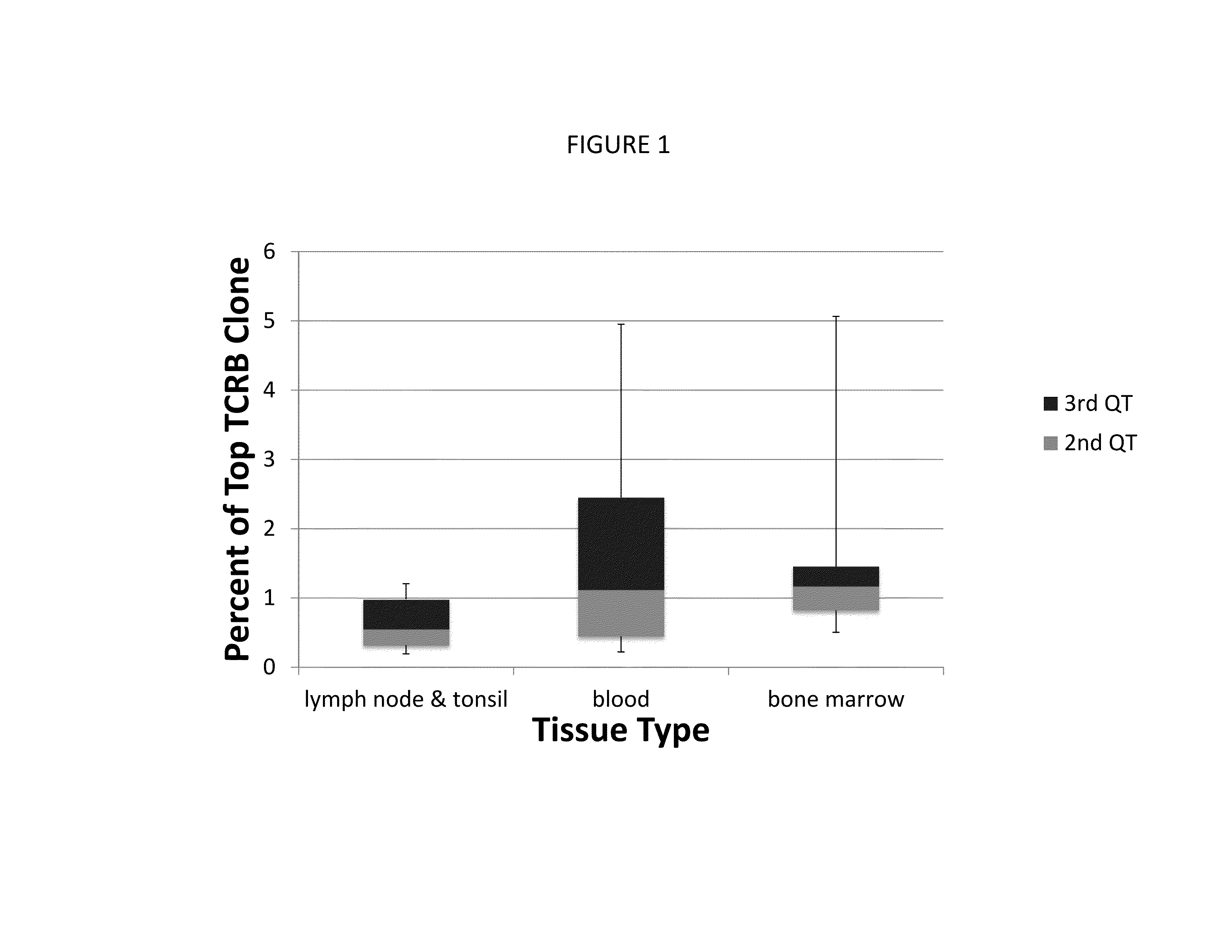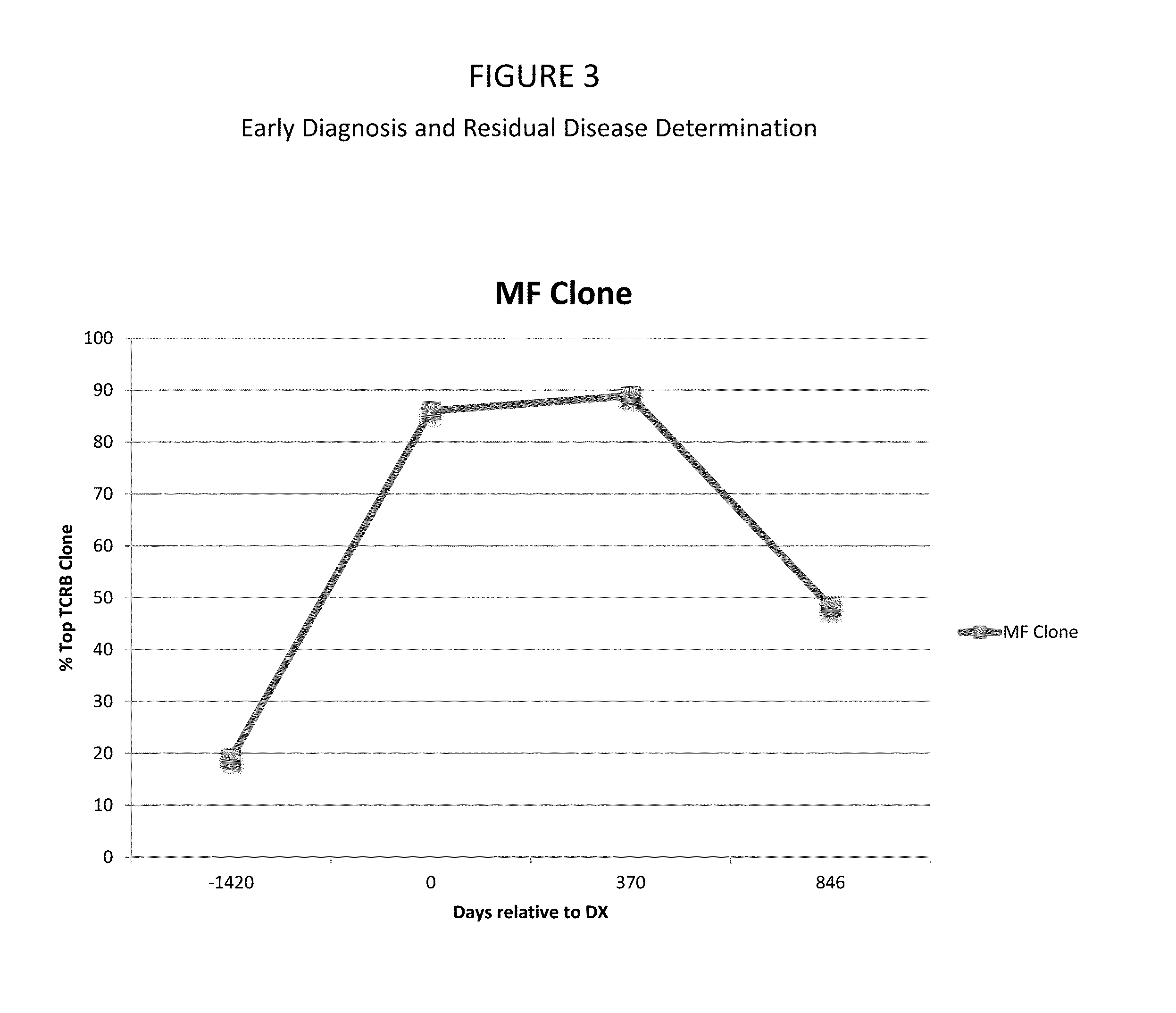Methods for detection and diagnosis of a lymphoid malignancy using high throughput sequencing
a lymphoid malignancy and high throughput sequencing technology, applied in the field of lymphoid malignancy detection and diagnosis using high throughput sequencing, can solve the problems of limited sensitivity, accuracy or timeliness of current methods for detection and diagnosis of lymphoid neoplasms, and difficult diagnosis of ctcl
- Summary
- Abstract
- Description
- Claims
- Application Information
AI Technical Summary
Benefits of technology
Problems solved by technology
Method used
Image
Examples
example 1
Characterization of T Cell Clonality and Malignancy Detection
[0231]In this example, samples of blood, bone marrow, skin, and lymph node and tonsil tissue from 99 patients were obtained from the University of Washington (Department of Laboratory Medicine). 96 of these patients had a presumed T-cell malignancy, and the remaining 3 patients had been diagnosed with a myeloproliferative disorder. Control samples were also obtained from individuals without evidence of leukemia, lymphoma, or other cancer (14 lymphoid tissue samples, 7 blood samples, 8 bone marrow samples), from the University of Washington.
[0232]Genomic DNA was prepared using a Qiagen DNA extraction kit from the samples of peripheral blood mononuclear cells (PBMCs), bone marrow, frozen or formalin-fixed paraffin-embedded (FFPE) 4 mm skin punch biopsies, or FFPE lymph node samples. DNA corresponding to 60,000-200,000 genomes was used for index clone identification. Approximately one million total cells were studied for dete...
example 2
Cutaneous T-Cell Lymphoma Detection
[0240]The methods of the invention were used to detect CTCL using HTS. 47 individuals were included in this study. 37 individuals had been previously diagnosed with CTCL or lymphoproliferative disease. 6 biopsies were taken from the skin of “normal” control individuals, 2 biopsies were taken from individuals having a suspect lesion, 1 biopsy was taken from an individual with a benign inflammatory infiltrate, and 1 biopsy was taken from an individual originally having a “diagnostic dilemma” and subsequently being diagnosed with eczematous hypersensitivity reaction.
[0241]Genomic DNA was prepared as described in Example 1. Multiplex PCR and HTS were also performed as described in Example 1.
[0242]The total number of observed rearranged CDR3 sequences in each sample was counted. The frequency of occurrence of each unique rearranged CDR3 sequence was calculated by dividing the number of counts of each unique rearranged CDR3 sequence by the total number o...
example 3
Identification of Expanded T Cell Clones Using High Throughput TCR CDR3 Region Sequencing and Discrimination of CTCL from Benign Inflammatory Skin Disorders
[0246]Materials and Methods
[0247]Skin and Blood Samples
[0248]The protocols of the studies in the examples were performed in accordance with the Declaration of Helsinki, and were approved by the Institutional Review Board of the Partners Human Research Committee (Partners Research Management) and the Dana Farber Cancer Institute Skin from healthy patients was obtained from patients undergoing cosmetic surgery procedures. Blood and lesional skin from patients with CTCL were obtained from patients seen at the Dana-Farber / Brigham and Women's Cancer Center Cutaneous Lymphoma Program. L-CTCL and MF patients described in this study met the WHO-EORTC criteria for CTCL. Lesional skin from patients with psoriasis and eczematous dermatitis were obtained from patients seen at the Brigham and Women's Hospital or at Rockefeller University.
[024...
PUM
| Property | Measurement | Unit |
|---|---|---|
| Frequency | aaaaa | aaaaa |
Abstract
Description
Claims
Application Information
 Login to View More
Login to View More - R&D
- Intellectual Property
- Life Sciences
- Materials
- Tech Scout
- Unparalleled Data Quality
- Higher Quality Content
- 60% Fewer Hallucinations
Browse by: Latest US Patents, China's latest patents, Technical Efficacy Thesaurus, Application Domain, Technology Topic, Popular Technical Reports.
© 2025 PatSnap. All rights reserved.Legal|Privacy policy|Modern Slavery Act Transparency Statement|Sitemap|About US| Contact US: help@patsnap.com



